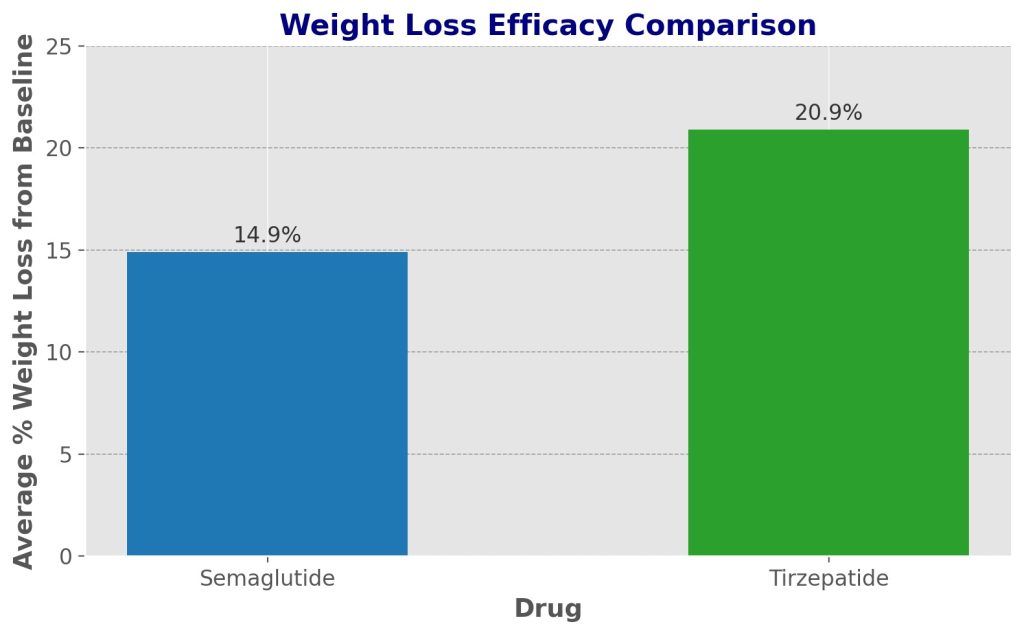Discovering the Best Weight Loss Medication? Wegovy versus Zepbound
GLP-1 Showdown: Semaglutide(Wegovy) Versus Tirzepatide(Zepbound)
New weight loss medications have been all the buzz lately, as several drugs for these purposes have hit the market over the past several years. The influx of new therapies brings new hope to patients, with two therapies emerging as frontrunners: semaglutide and tirzepatide. Both medications have demonstrated robust results regarding weight management, but what’s the difference? To answer this question, we’ll explore the nuances of these drugs so that you can make informed decisions about your health.
Indications: Appropriate use of GLP-1 Medications
When it comes to disease states, both semaglutide and tirzepatide are indicated for diabetes and weight loss. They are marketed under different brand names for different purposes, as outlined below:
| Drug | Brand name | Indication |
| Tirzepatide | Mounjaro | To improve blood sugar control in addition to diet and exercise in those with type 2 diabetes (1) |
| Zepbound | Chronic weight management in addition to diet and exercise in those that are obese or overweight with one weight-related condition (2) | |
| Semaglutide | Ozempic | To improve blood sugar control in addition to diet and exercise in those with type 2 diabetes (3) |
| Wegovy | Chronic weight management in addition to diet and exercise in those who are obese or overweight with one weight-related condition (4) |
Compounded semaglutide is not a mass-produced drug but is custom-made in pharmacies to cater to individual patient needs. It varies in dosage and formulation based on medical prescriptions.
How do these GLP-1 agonist weight loss medications work?
Both semaglutide and tirzepatide function as glucagon-like peptide-1 receptor (GLP-1) agonists. When it comes to diabetes, GLP-1 medications work in the following ways:
- Increasing insulin secretion
- Preventing glucagon production
- Supporting pancreas cell growth and development
The mechanism of GLP-1s doesn’t stop there. Both semaglutide and tirzepatide slow gastric emptying, which refers to the process by which food moves through your digestive tract. By delaying gastric emptying, you feel fuller for longer. When you are more satiated, you eat less food and lose weight in the process (5). This is why both drugs also work for weight loss.
Though both medications share a mechanism as a GLP-1, tirzepatide has an additional mechanism contributing to its efficacy. It also functions as a glucose-dependent insulinotropic polypeptide (GIP) agonist. As a GIP agonist, tirzepatide mimics the GIP hormone, which also helps to regulate insulin (6).
Dosing for weight loss
Semaglutide and tirzepatide are both administered as once-weekly injections. However, they differ slightly with regard to dosing. Their dosing regimens will also vary depending on the indication and an individual’s response to therapy. Typical dosing for weight loss of each medication is as follows in the table below:
| Semaglutide | Tirzepatide |
| Starting dose: 2.5 mg once weekly. Target dose: 5-15 mg once weeklyMaximum dose: 15 mg once weekly (2) | Starting dose: 2.5 mg once weekly Target dose: 5-15 mg once weeklyMaximum dose: 15 mg once weekly (2) |
Expected weight loss: Semaglutide vs. Tirzepatide
Though there are a few differences between semaglutide and tirzepatide, everyone wants to know which is more effective. Both medications provide excellent results for weight loss. However, because tirzepatide has a dual action as a GLP-1 and GIP agonist, it could produce more robust results. One study known as the SURPASS-2 trial aimed to evaluate how exactly the two medications might differ.
The SURPASS-2 study compared semaglutide and tirzepatide head-to-head over the course of 40 weeks, enrolling over 1,800 patients with diabetes who were randomized to receive either semaglutide 1 mg, tirzepatide 5 mg, tirzepatide 10 mg or tirzepatide 15 mg. Results indicated that tirzepatide induced more profound weight loss than semaglutide at 40 weeks, with average weight losses being:
- Semaglutide 1 mg: – 5.7 kg
- Tirzepatide 5 mg: – 7.6 kg
- Tirzepatide 10 mg: – 9.3 kg
- Tirzepatide 15 mg: – 11.2 kg
It is important to note that the trial was predominately focused on tirzepatide. In the clinical trial for Wegovy, Semaglutide injection at 2.4 mg once a weekly dose was found to result in 15.3% weight loss at the end of 68 weeks of treatment.
| Treatment | Average Weight Loss (kg) |
|---|---|
| Semaglutide 2.4 mg | -15.3 kg |
| Placebo | -2.6 kg |
Weight Loss Efficacy at higher doses of Semaglutide and Tirzepetide
| Drug | Dose | Average % Weight Loss from Baseline |
|---|---|---|
| Semaglutide | 2.4 mg | 14.9% |
| Tirzepatide | 10 mg / 15 mg | 20.9% |

In summary, you can see that tirzepatide at all dose levels was superior to semaglutide for weight management (7). Thus, it may provide more robust weight loss effects in clinical practice. We do not endorse one medication over another. The suitability of the medication is to be determined based on a comprehensive evaluation.
Side effects: Semaglutide vs. Tirzepatide
Because both semaglutide and tirzepatide share similar mechanisms, they also have a comparable side effect profile. As GLP-1s, the most common side effects are related to the gastrointestinal (GI) tract.
Aside from efficacy, the SURPASS-2 trial also analyzed how semaglutide and tirzepatide compare with regard to side effects. There were some slight differences in side effect frequency between tirzepatide and semaglutide; however, the overall rate of GI-related side effects was similar (between 40 to 46 percent). Individual frequencies of the most common adverse effects for the two medications were as follows (7):
| Tirzepatide 5 mg | Tirzepatide 10 mg | Tirzepatide 15 mg | Semaglutide 1 mg | |
| Nausea | 17.4% | 19.2% | 22.1% | 17.9% |
| Diarrhea | 13.2% | 16.4% | 13.8% | 11.5% |
| Vomiting | 5.7% | 8.5% | 9.8% | 8.3% |
| Indigestion | 7.2% | 6.2% | 9.1% | 6.6% |
| Low appetite | 7.4% | 7.2% | 8.9% | 5.3% |
| Constipation | 6.8% | 4.5% | 4.5% | 5.8% |
| Stomach pain | 3% | 4.5% | 5.1% | 5.1% |
| Total GI-related side effects | 40% | 46.1% | 44.9% | 41.2% |

Rates of serious side effects such as pancreatitis – inflammation of the pancreas, Acute Kidney Injury(AKI), Diabetic retinopathy, and gall bladder diseases such as cholelithiasis and cholecystitis were similar with Semaglutide and Tirzepetide.
Link to Medullary Thyroid Cancer or Multiple Endocrine Neoplasia syndrome type 2 (MEN 2)
These concerns primarily stem from animal studies. Here are some key findings:
Rodent Studies: Research in rodents has shown that some GLP-1 receptor agonists can stimulate the growth of calcitonin-producing cells, known as C-cells, in the thyroid. Overstimulation of these cells has been linked to the development of C-cell hyperplasia, a potential precursor to medullary thyroid cancer.
Species Differences: It’s important to note that the physiology of rodent C-cells differs significantly from that of humans. Rodents have a higher baseline level of C-cell activity and are more susceptible to C-cell hyperplasia and tumors when exposed to stimuli that would be relatively benign in humans.
Human Implications: While these findings have led to cautionary labeling on GLP-1 receptor agonists, the direct applicability to human risk remains uncertain. Long-term clinical studies and post-marketing surveillance in humans have not shown a clear association between GLP-1 receptor agonists and an increased risk of medullary thyroid cancer. However, as a precaution, these medications are typically contraindicated in patients with a personal or family history of medullary thyroid cancer or in patients with Multiple Endocrine Neoplasia syndrome type 2 (MEN 2).
FDA and Regulatory View: Based on animal data, the U.S. Food and Drug Administration (FDA) requires a warning about the potential risk of thyroid C-cell tumors on the labels of GLP-1 medications. However, the FDA also acknowledges the lack of direct evidence linking these medications to MTC in humans.
Cost Comparison for Ozempic(Semaglutide) vs. Mounjaro(Tirzepetide)
Another significant factor to consider when selecting a medication is the cost. Neither drug has a generic available, meaning you can only buy the brand version, which tends to be more expensive. The price of both semaglutide and tirzepatide will vary depending on insurance coverage and the patient’s pharmacy.
Semaglutide is generally more affordable than tirzepatide, but not by much. If paying for the medication out of pocket, the pricing of each medication per month is as follows:
- Semaglutide (Brand Name: Ozempic, Wegovy): ~$950-1,100 (8)
- Tirzepatide(Brand Name: Mounjaro and Zepbound): ~$1,050-1,200 (9)
Compounding
If a drug is in shortage, compounders can create a compounded form of the medication in line with the Federal Food, Drug, and Cosmetic (FD&C) Act. As of April 2024, tirzepatide and semaglutide are currently on the FDA’s drug shortages list (10). However, it is essential to note that the FDA does not assess compounded drugs for efficacy, safety, and quality. Thus, there are some inherent risks with using compounded versions of these medications. For example, there have been reports to the FDA with issues regarding the ingredients in compounded semaglutide (11). It is crucial not to get the medication from the cheapest source available but from a verified compounding pharmacy that goes through a rigorous process to maintain the medication’s quality.
Conclusion
In summary, semaglutide and tirzepatide share several similarities, including their activity as GLP-1 agonists, indications, cost, and side effects. However, tirzepatide has an additional mechanism as a GIP that may contribute to its enhanced effectiveness in weight loss.
Ultimately, the decision as to which medication is right for you should be shared between you and your healthcare provider. Your provider can assess your health status, medical history, preferences, and response to therapy to determine which medication is best for you. The good news is that both medications are safe and effective, so you can’t lose either way.
Author:
Have more questions?
Schedule a complimentary telemedicine visit with a board-certified medical doctor. During your visit, you will receive a comprehensive medical evaluation, an assessment of your suitability for weight loss treatment, verification of your insurance coverage for the medication, and personalized answers to all your questions. Schedule your appointment today!
– No Credit Card Required. Sign up only if you see value.
References
- https://www.accessdata.fda.gov/drugsatfda_docs/label/2022/215866s000lbl.pdf
- https://pi.lilly.com/us/zepbound-uspi.pdf
- https://www.accessdata.fda.gov/drugsatfda_docs/label/2017/209637lbl.pdf
- https://www.accessdata.fda.gov/drugsatfda_docs/label/2023/215256s007lbl.pdf
- https://www.ncbi.nlm.nih.gov/books/NBK551568/
- https://www.ncbi.nlm.nih.gov/books/NBK546653/
- https://www.nejm.org/doi/full/10.1056/NEJMoa2107519
- https://www.goodrx.com/ozempic
- https://www.goodrx.com/tirzepatide
- https://www.accessdata.fda.gov/scripts/drugshortages/default.cfm
- https://www.fda.gov/drugs/postmarket-drug-safety-information-patients-and-providers/medications-containing-semaglutide-marketed-type-2-diabetes-or-weight-loss





